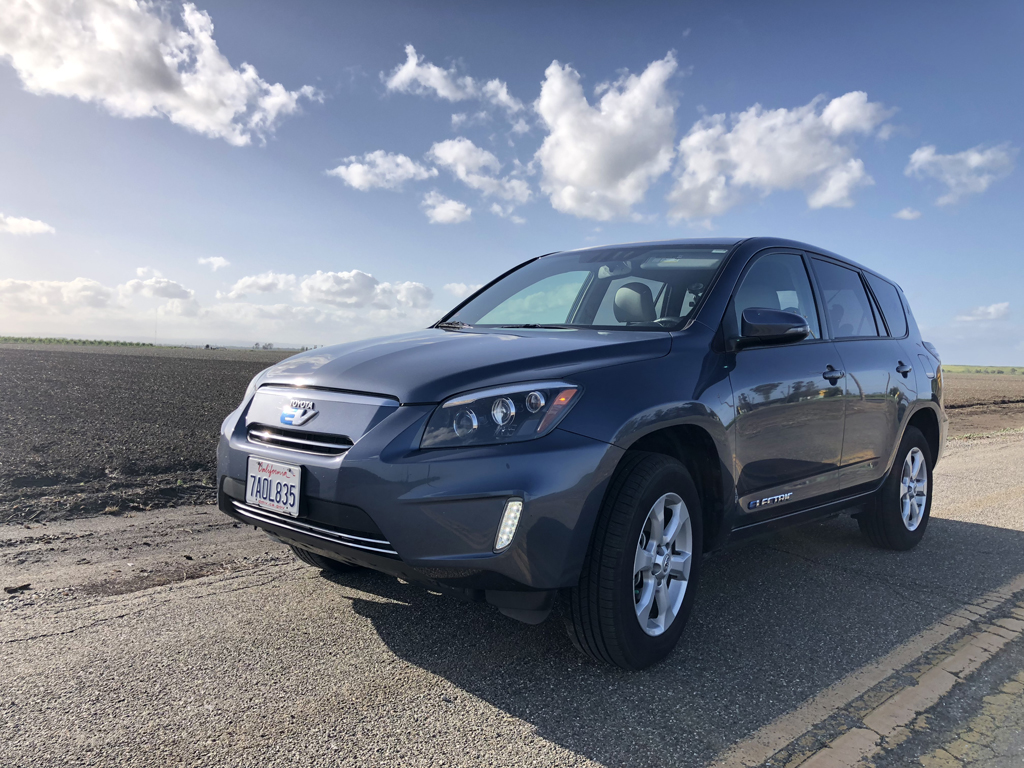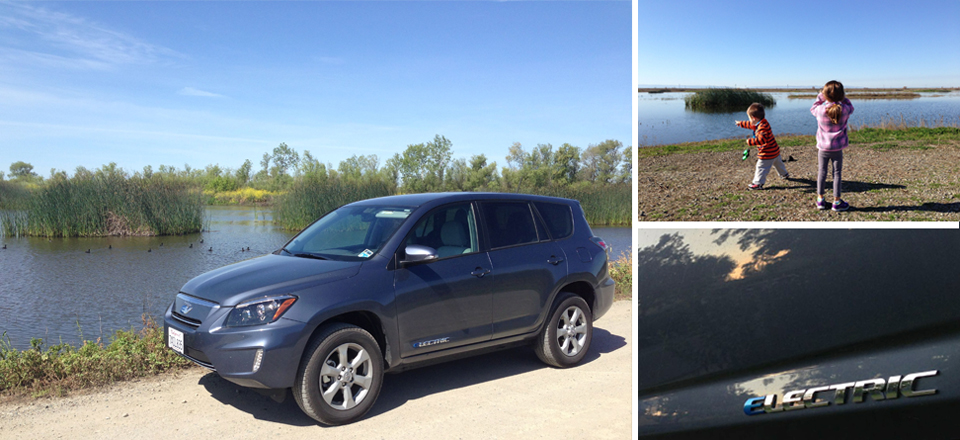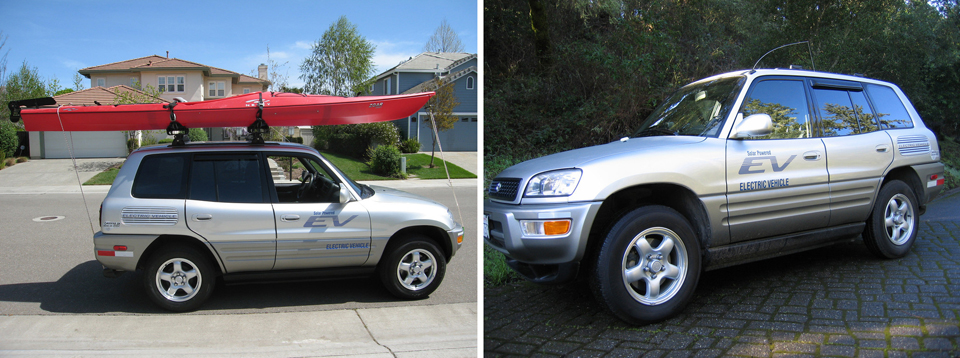This review was originally published in 2014 on the Transport Evolved website. The review was based on my experiences after driving the all-electric 2012 Rav4 EV for one year.
This review of the Rav4 EV is also intended as a primer for those who are learning about electric vehicles (EVs), those considering the switch from gasoline to electric, and those wondering if driving an EV will fit their lifestyle. The review is broken down into three installments that cover:
- 1) RAV4 EV BASICS
- 2) CHARGING
- 3) BENEFITS OF DRIVING ELECTRIC
Benefits of Driving Electric
- Cheaper Cost of Driving Electric versus Gas
The lower daily cost of driving an electric car is not the most important benefit, but it deserves mention. We used about 330 kWh of electricity to drive 1090 miles in our EV each month. At 13.3 cents per kWh in our area, that works out to $44 a month, or about 4¢ per mile. For comparison we paid $88 dollars per month, or 7.2¢ per mile to gas up our 50 MPG Prius, and AAA estimates that the average new car costs about $175 per month, or 15¢ per mile.
Charging an EV at home will increase your electricity bill, but this will be offset by the larger savings from not buying gas. There will be additional savings since EVs don’t require oil changes, filter changes, etc. Check with your local utility to learn about time of use plans, electric vehicle rate plans, and tiered rate plans to determine what is available in your area.

- Reduced Carbon Footprint
Burning a gallon of gas releases 19.6 pounds of CO2 into the atmosphere (US Energy Information Administration). CO2 is not a weightless gas that disappears into the atmosphere. The average American driver generates approximately their body weight in carbon dioxide every week by driving a gasoline burning car. So imagine how much we weigh, how many of us are driving, and ask yourself where does it all go.
Before getting our electric car, we drove a Prius as our main car and a Corolla for days when we each needed a car. We burned up 408 gallons of gas in the two cars in one year, so our two cars generated more than 8000 pounds of CO2 in one year. Now we use the Rav4 EV as our main car and the Prius for those days when we both need a car. The electric car used nearly 4000 kWh of electricity, which in California produces 2440 pounds of CO2 (US EIA), and we burned 94 gallons of gas in the Prius, releasing another 1850 pounds of CO2. So the EV and Prius combined produced 4290 pounds of CO2 in one year. By driving an EV we cut our carbon emissions in half (for more information see this report).
Mining, extraction and transportation of fuels add to those numbers for both gas and electric. But gasoline doesn’t come ready-made out of the ground. It is produced from petroleum in refineries through a process that uses a considerable amount of electricity, releasing pollution into the air even before that gasoline is delivered to your gas station.
- Reduced Pollution
CO2 is only one pollutant released by burning gasoline: nitrogen oxides, sulfur dioxide, carbon monoxide, particulate matter, and additional hazardous compounds are also released into the air we breath. Recent evidence suggests a link between air pollution and infant health problems, childhood asthma, and chronic respiratory disease in adults. More studies are needed, but we owe it to our children, and ourselves, to reduce pollution everywhere possible. Electric vehicles are one way to reduce pollution, and not 10 years down the road but today.
The amount of pollution you make charging an electric car depends on the source of energy for generating electricity in your area. If 100% of the electricity in your area is generated from coal, charging an EV will produce pollution equivalent to driving a car that gets 33 MPG. But in many parts of the country coal is no longer the main source of electricity, and the proportion of electricity generated by renewable sources is steadily growing each year. The Union of Concerned Scientists examined this issue throughout the U.S twice. In 2012 and 2014. In California charging an electric car produces an amount of pollution that is equivalent to driving a car that gets 95 MPG (See the UCS report for details).
It’s also important to note that if you buy an electric car the amount of pollution produced to charge your EV will decrease year by year as more renewables are added to the grid, and as utilities reduce emissions at the plant. In contrast, if you buy a gasoline powered car the amount of pollution you produce is fixed for the lifetime of the car. Whether or not you believe in global warming, pollution is real. If you’re not convinced, stand next to a busy freeway, breath deeply, and ask yourself, “Where does all that exhaust go?”
A great way to reduce pollution is by installing solar panels. Costs have dropped dramatically in recent years and affordable options exist for buying or leasing solar panels. Up front costs for buying solar are cheaper than buying a car, and leasing options may have no up front costs. The benefits are huge. I know EV drivers who installed solar panels and generate enough electricity, right on the roof of their house, to power their home and their electric car. They’ve become net-zero energy users, and are closing in on true zero emissions. This is an incredibly powerful and pollution free way to charge cars. For a great example of driving on sunshine read about the Honda Home in Davis, CA.
- Domestic Energy = Independence
The US transportation system relies heavily on oil. In 2012 40% of our oil came from OPEC, 10% from Venezuela, 5% from Russia. In 2012 the US spent 433 billion dollars importing foreign oil – over a billion dollars every day. It goes without saying that national security issues are at stake. Every day we send tens of millions of dollars in profits to countries not aligned with our interests. This isn’t abstract money sent from some governmental department, but money that comes right out of our wallets. Money that bankrolls projects and activities we should not support. Knowing this should stimulate efforts to enable the realistic alternatives, like electric cars, that exist right now. Supplying a greater proportion of our transportation energy needs with domestic energy to power efficient electric vehicles will reduce our reliance on foreign oil, benefit our environment, and produce more jobs here at home.

- Zero Emissions
Since I’ve been driving an EV every day I’ve realized many benefits of zero emissions from the tailpipe. To name only two: when I pull into the garage exhaust fumes don’t follow us into the house; and we can now drive silently through wildlife areas without releasing pollution into the nature reserve. Hopefully charging networks will soon extend to national parks.
- A Story of What Could Have Been:
You may not have heard about the Rav4 EV because Toyota does not advertise it in any meaningful way. No TV, radio, billboard or print ads. Nothing you’d expect from a company trying to sell a car. In fact, Toyota recently ran advertisements against the Rav4 EV through it’s Lexus subsidiary. An amazing strategy: make a car, campaign against it, then announce that nobody wants it. But this was Toyota’s plan from the start. The Rav4 EV is a ‘compliance car’ built solely to meet California state law. Only 2600 will be built, and they are only sold in California. EV enthusiasts from around the country have bought the Rav4 EV and shipped it to their homes, but Toyota’s position has been that they will not honor warranty service for out-of-state owners. This is an important issue since warranties are regulated by federal law.
The new Rav4 EV is actually the second version of this car. Toyota designed and built the an earlier version of the Rav4 EV between 1997-2003, also to meet California state law. When state legislators revised zero emission law in 2003 to ease requirements on auto manufacturers, Toyota, GM, Honda, and Ford crushed their electric cars as quickly as they could. But as a result of protests, legal action and publicity, more than 300 first generation Rav4 EVs escaped the crusher, and several of those durable first generation Rav4 EVs are still driving around my town 10+ years later.

To build the second generation Rav4 EV, Toyota contracted Tesla to supply the battery, motor and electronics. The Tesla components provide the powerful thrill ride we enjoy, but the new Rav4 EV was put on the market before all the kinks were worked out. We haven’t had any problems with our Rav4 EV, but others have experienced a range of problems. The electronic link between Toyota and Tesla components may be an issue. Toyota handles all service, but in some cases only Tesla service reps have the proprietary knowledge required to fix problems. This is not surprising given Toyota’s lack of interest and the small number of Rav4 EVs that have been built. Toyota’s anti-EV stance has turned off many who were originally enthusiastic about the new Rav4 EV. In contrast, electric cars built by dedicated automakers, think Nissan Leaf and Tesla Model S, are reliable and have very satisfied and loyal customers.
Toyota recently pronounced the end of the Rav4 EV program. Toyota claims that EVs are too expensive, are not profitable, and that nobody wants them. But this is exactly what other automakers said about hybrids when Toyota invested heavily to develop the first generation Prius and initially sold it at a loss. We know how that story ended: economy of scale brought down manufacturing costs and Toyota dominates the lucrative hybrid market.
- Conclusion
After 13,000 trouble free miles I love my electric car more than any I’ve ever driven. Knowing that it is powered by domestic energy, including 25% from renewable sources like hydroelectric, wind, and solar is a huge plus. It’s too bad that Toyota made the absolute minimum effort required to conform with California state law in producing the Rav4 EV. If supported and properly promoted, the Rav4 EV would serve an important segment of the electric car market. Instead Toyota throws shade at the battery electric cars through nonsense ads placed by it’s subsidiaries.
My next car will definitely be a battery electric car and I will buy from a company committed to moving this technology forward. My advice to you? If the range of an electric car is greater than your daily commute, buy one. It works for us and it’ll work for you. If your driving needs exceed the range of current EVs on the market, there are a number of plug-in hybrid vehicles like the reliable Chevy Volt, that could meet your needs.
There are many resources for learning about the electric cars on the market now, including My Electric Car Forums. Many people who participate in these sorts of forums are very knowledgeable electric car owners, and they’d be happy to answer any questions you might have. I’d also check out organizations like Plug-in America that provide lots of useful information about electric cars.
If you missed the earlier installments, click here to read:

